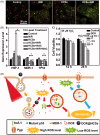Mesoporous carbon nanomaterials in drug delivery and biomedical application
- PMID: 29124979
- PMCID: PMC8812584
- DOI: 10.1080/10717544.2017.1399300
Mesoporous carbon nanomaterials in drug delivery and biomedical application
Abstract
Recent development of nano-technology provides highly efficient and versatile treatment methods to achieve better therapeutic efficacy and lower side effects of malignant cancer. The exploration of drug delivery systems (DDSs) based on nano-material shows great promise in translating nano-technology to clinical use to benefit patients. As an emerging inorganic nanomaterial, mesoporous carbon nanomaterials (MCNs) possess both the mesoporous structure and the carbonaceous composition, endowing them with superior nature compared with mesoporous silica nanomaterials and other carbon-based materials, such as carbon nanotube, graphene and fullerene. In this review, we highlighted the cutting-edge progress of carbon nanomaterials as drug delivery systems (DDSs), including immediate/sustained drug delivery systems and controlled/targeted drug delivery systems. In addition, several representative biomedical applications of mesoporous carbon such as (1) photo-chemo synergistic therapy; (2) delivery of therapeutic biomolecule and (3) in vivo bioimaging are discussed and integrated. Finally, potential challenges and outlook for future development of mesoporous carbon in biomedical fields have been discussed in detail.
Keywords: Mesoporous carbon nanomaterials; biocompatibility; biomedical applications; drug delivery systems; photothermal therapy.
Conflict of interest statement
The authors report no conflicts of interest.
Figures





Similar articles
-
Drug delivery/imaging multifunctionality of mesoporous silica-based composite nanostructures.Expert Opin Drug Deliv. 2014 Jun;11(6):917-30. doi: 10.1517/17425247.2014.908181. Epub 2014 Apr 19. Expert Opin Drug Deliv. 2014. PMID: 24746014 Review.
-
Aerosol technique-based carbon-encapsulated hollow mesoporous silica nanoparticles for synergistic chemo-photothermal therapy.Acta Biomater. 2019 Apr 1;88:448-461. doi: 10.1016/j.actbio.2019.02.029. Epub 2019 Feb 26. Acta Biomater. 2019. PMID: 30818051
-
Tailored Mesoporous Inorganic Biomaterials: Assembly, Functionalization, and Drug Delivery Engineering.Adv Mater. 2021 Jan;33(2):e2005215. doi: 10.1002/adma.202005215. Epub 2020 Nov 30. Adv Mater. 2021. PMID: 33251635 Review.
-
Mesoporous silica nanoparticles in drug delivery and biomedical applications.Nanomedicine. 2015 Feb;11(2):313-27. doi: 10.1016/j.nano.2014.09.014. Epub 2014 Nov 13. Nanomedicine. 2015. PMID: 25461284 Review.
-
Optically active organic and inorganic nanomaterials for biological imaging applications: A review.Micron. 2023 Sep;172:103486. doi: 10.1016/j.micron.2023.103486. Epub 2023 May 24. Micron. 2023. PMID: 37262930 Review.
Cited by
-
Insight into Potential Biomedical Application of Mesoporous Materials.Pharmaceutics. 2022 Nov 4;14(11):2382. doi: 10.3390/pharmaceutics14112382. Pharmaceutics. 2022. PMID: 36365200 Free PMC article. Review.
-
Harnessing the tunable cavity of nanoceria for enhancing Y-27632-mediated alleviation of ocular hypertension.Theranostics. 2021 Mar 13;11(11):5447-5463. doi: 10.7150/thno.54525. eCollection 2021. Theranostics. 2021. PMID: 33859757 Free PMC article.
-
Synthesis and Characterization of Nanoporous Carbon Carriers for Losartan Potassium Delivery.Materials (Basel). 2021 Nov 30;14(23):7345. doi: 10.3390/ma14237345. Materials (Basel). 2021. PMID: 34885515 Free PMC article.
-
Carbon nanotubes/ordered mesoporous carbon/chitosan nanocomposite as a promising carrier for everolimus targeted delivery toward lung cancer cells.J Mater Sci Mater Med. 2025 May 31;36(1):46. doi: 10.1007/s10856-025-06901-7. J Mater Sci Mater Med. 2025. PMID: 40450161 Free PMC article.
-
Application of Green Gold Nanoparticles in Cancer Therapy and Diagnosis.Nanomaterials (Basel). 2022 Mar 27;12(7):1102. doi: 10.3390/nano12071102. Nanomaterials (Basel). 2022. PMID: 35407220 Free PMC article. Review.
References
-
- Ai K, Liu Y, Ruan C, et al. (2013). Sp2 C-dominant N-doped carbon sub-micrometer spheres with a tunable size: a versatile platform for highly efficient oxygen-reduction catalysts. Adv Mater 25:998–1003. - PubMed
-
- Akhavan O, Ghaderi E. (2013). Graphene nanomesh promises extremely efficient in vivo photothermal therapy. Small 9:3593–601. - PubMed
-
- Alhmoud H, Delalat B, Elnathan R, et al. (2015). Porous silicon nanodiscs for targeted drug delivery. Adv Funct Mater 25:1137–45.
-
- Bai L, Zhao Q, Wang J, et al. (2015). Mechanism study on pH-responsive cyclodextrin capped mesoporous silica: effect of different stalk densities and the type of cyclodextrin. Nanotechnology 26:165704. - PubMed
-
- Boesch D, Gavériaux C, Jachez B, et al. (1991). In vivo circumvention of P-glycoprotein-mediated multidrug resistance of tumor cells with SDZ PSC 833. Cancer Res 51:4226–33. - PubMed
Publication types
MeSH terms
Substances
LinkOut - more resources
Full Text Sources
Other Literature Sources
Research Materials
